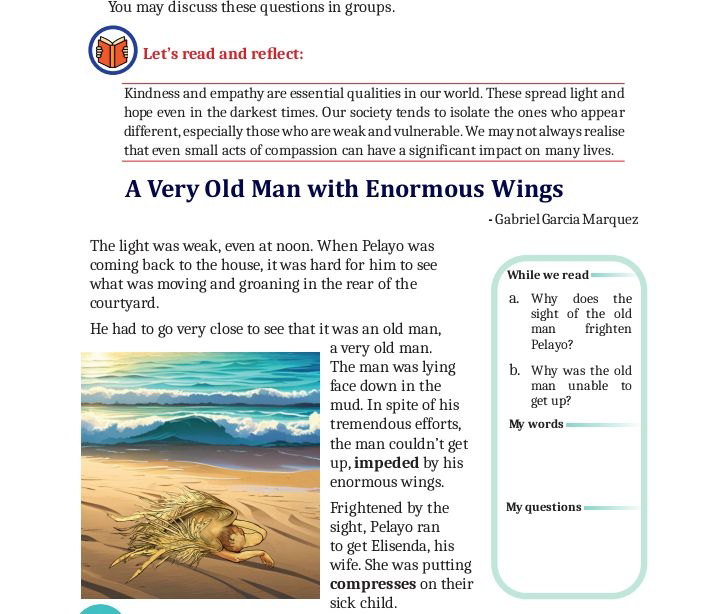RICE - Chemmanam Chacko
RICE
Chemmanam Chacko
READ AND RESPOND
1. Of all memories of his homeland, the narrator thinks of 'rice' first. What does this show?
It shows his extreme love for rice. He is a rice eater. For the last four years he has been eating chapattis. Now is craving for rice.
2. What are the nemories of the narrator about the paddy cultivating season?
He remembers his father in the fields below his house. He is wearing a handloom dhoti stained with yellow mud. He is excited about the water of the Varanganal canal. He also remembers his little brother carrying the tender saplings to be planted where the ploughing is done. On the dyke baskets full of seeds are kept. There is the noise of shouting as tbe oxen draw the plough in the field.
3. The narrator wants the train to move a little faster. What does this tell us about his feeling for his native village?
It tells that he loves his village dearly. He has been missing it for long. He wants to reach it as quickly as possible. We see his nostalgic feelings here.
4. What changes in his native village does the narrator notice on his return?
There are many changes in his native village. The palm- thatched houses are gone. There are only rubber plants there. There are no rice fields anymore. There is no noise of people below. No shouts of ploughing. The whole field is planted with arecanut palms. In the corner, along the canal, there are the dealwood trees which were not there before.
5. Rubber plants have taken the place of paddy. What does this imply?
It implies that food crops are replaced by cash crops. People don't any more cultivate their favourite varieties like Athikira, midan and vellaran. Now they survive on their rations which consist of wheat.
6. "Only fools turn to rice farming for gain". Why does the father say so?
The father says so because nobody promotes the farming of rice. Rice farming was quite inconvenient and the farmer gained nothing. Rubber brings better money. The government gives rice to those who have no paddy fields.
7. What does the ship of the sky represent?
It reoresents the aeroplane, as the ship of the desert represents the Camel.
8. " Can we get some husk from the centre too, to make toys with it?" Bring out the satire in these lines.
The poet had gone to North India and did a four year reserch on making toys with husk. He got a doctoral degree at the end of his reserch. Now he comes back to Kerala to findout that there is no more rice cultivation here and consequently no husk to make toys with. To make toys with husk, he has to get husk from the centre. He did the reserch to help the state to find employment and income. What use the state will have now with his doctorate.
ACTIVITY - 1 ( Critical Appreciation)
Prepare a critical appreciation of the poem in the light of your responses to the questions above.
The poem "Rice" written by Chammanam Chacko and translated by Prof. Ayyappa Panicker is a superb satire hitting hard at the greed of some farmers here. The poem is laced with scorn and sarcasm. The son of a rice farmer goes to North India to do a reserch on making toys with husk. He works hard for four years, eating chapatti day after day, and finally succeeds in getting a doctorate. He must have thought of doing research on the possibilities of husk because as the son of a rice farmer he had plenty of husk at home and also in the homes nearby. By using husk for toy making, a lot of people could find employment in a state notorious for unemployment.
But then there is the anticlimax. When the son returns home with his well earned doctorate on making toys with husk, there is no husk at all in his house or around. Farmers had shifted to cash crops, especially rubber, as they found rice cultivation is inconvenient and non-profitable. Moreover a lot of incentives were given by promoters to cultivate cash crops. The son finds his father watching people setting up a machine for making rubber sheets. All the paddy fields are gone and in their place what he sees are rubber trees and deal wood trees.
There is biting sarcasm in the description of the chief minister trying to tbe centre to request for more food grains to feed the people here. There is no more rice to eat. People have to eat wheat. The son comes home after four years with a desire to eat his favourite 'athikira' rice. But his desire will remain an unfulfilled desire as he too has to eat the wheat that is given to the household as ration. And his doctoral degree? How can he find husk to make toys.
I would not call it an exquisite poem comparable to the poems of wordsworth, Coleridge, Shelley or Keats. But it can stand comparison with the poetry of Alexander Pope who excelled in satire. The poem has excellent imagery. The poet has used a number of Malayalam words in the poem. The language is colloquial. The stanzas of the poem are irregular - ranging from two lines to six. It is a prose - poem. Being a satirical poem, the style is simple, direct and lucid and it suits the theme. Chemmanam Chacko has done a good job in showing how the farmers have changed from simple people to shrewd commercially minded people.
ACTIVITY II
Chemmanam Chacko is a master satirist who has fought many a battle with the system through his writings, laced with scorn and sarcasm. He says, ‘Socio-political sphere is much meek and limited compared with earlier times. Society
has changed and with it, have the mass sensibilities.’ Consider his poem ‘Rice’ as a satire on the farmers who are forced to switch to cash crops when the market for
food crops fell. Prepare a write-up.
‘Rice’ is a poem originally written in Malayalam by Chemmanam Chacko and
translated into English by Prof.Ayyappa Panicker. The poem hints at the recent
trends in farming in our country and its reducing importance due to the move
towards commercial crops and its benefits. The poet here returns to his homeland with a doctorate on making toys with husk. But to his surprise, he finds the cash crops in the place of Paddy- cultivation.
India is largely an agrarian country. In the contemporary world, We find people
keep themselves away from agriculture except for remunerative crops. There has
been noticeable changes in the cropping patterns mainly due to some socio-
economic factors like increasing need of income, changing life styles. Influencing
modern technology etc. People change with the change. They don’t realize the
fact that shifting from cash crops to food crops is essential for meeting the food
sufficiency in our country. The poem mirrors this truth. While the poet has come home eagerly to have athikira rice and to be a part of the farming community by
making husk-toys, his father says with a pride that ‘not like fools’ he is doing a
better work . He says this with content, watching the machine making rubber
sheets. The father considers this change as wise and profitable. The poet satirically ends the poem by saying if they could get husk from the centre to make
toys with it. It is a hit at the society’s attitude of accepting anything not bothering of or considering the consequences. The poem criticizes the present scenario prevailing in agri- sector. Thus it highlights the growing need for farming to satisfy our basic needs and the effects of commercialization.
ACTIVITY III
Instead of a system of values, we have the market ruling us. Making decisions for
us. Consider this statement in the light of the poem “ Rice” by Chemmanam Chacko.
India is an agrarian country and agriculture, the main occupation of the people. Since Indian agriculture has to feed a large population, the production of food crops is the first priority of farmers in our country. But, in recent times, there has
been a change, a shifting pattern – from food crops to cash crops and also decline
in the use of land for agrarian purpose because of various other commercially
advantageous uses of land.
Food is the basic need of mankind. But more importance is given to commercialising agricultural production. With the changing agriculture scenario
and global market competition, there is exploitation and misuse of the available
resources. As a result commercial farming exists. It is evident as there is decline in
area producing food crops.
Earlier days, marketing of agri-products had no difficulty as the farmer sold his produce to the consumer on a cash or barter basis. Now-a-days most of the products are sold for earning money. Most of the farm lands are owned by people who have no interest in agriculture. The products are graded for export. The
demand and profit of it determine the supply and value. Cash crops could earn
more profit than food crop. Hence, efforts have been done for further increase of
productivity of cash crops and changes in crop pattern. It can be said that farmer
is a mere tool who is used for the purpose of productions of flourishing market
value. Ultimately farming has lost its traditional value instead got a commercial
recognition.To some extent all these can be said to be an aftermath of commercialisation, modernization and globalization.




Tnx
ReplyDelete